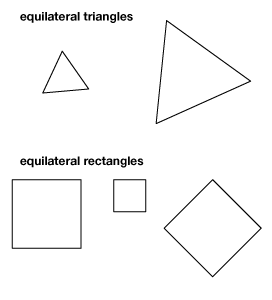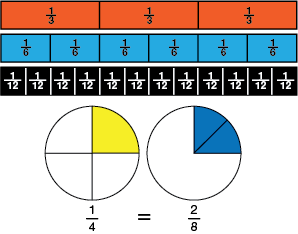E
end point
The point on a plane where a line segment ends.

page 373
equal to
Having the same value (=).
pages 358–363
equation
A true number sentence can also be called an equation because the amounts on both sides of the equal sign are the same.
pages 123–125
equilateral
A shape with all sides and all angles equal.

page 422
equivalent
The same as or equal to.
pages 299, 334–341, 358–363
equivalent fractions
When two fractions represent the same part of the whole, they are called equivalent. For example, 





pages 299, 334–341, 358–363
estimate
1. (verb) To find about how many.
2. (noun) An approximate number.
pages 128–136, 146–151, 234–246, 271–277, 278, 353–354, 384–395, 541–543
even number
Numbers that are multiples of 2 (2, 4, 6, 8, etc.) are called even numbers.
pages 68–70
expanded form
Shows a number expanded into its place value parts. For example: 423 = 400 + 20 + 3. The examples below show how to use expanded form to add, subtract, and multiply.

pages 104–105, 113, 125, 128, 130, 141, 143, 155–156, 158, 279–281, 285–287, 491–500, 501–507
exponent
The number of times the base is multiplied by itself. In 34 = 3 × 3 × 3 × 3, the 3 is the base and the 4 is the exponent. The 3 is multiplied by itself 4 times.

pages 69–71, 93–96, 99–100, 225–226
expression
Mathematical symbols that represent a quantity, e.g., 4 + 3 × 12. The information on either side of an equal sign (=) or greater than (>) or less than (<) symbol.
page 255
extrapolate (extrapolation)
Using patterns in data to make predictions
or to estimate values that lie beyond the
range of values in the set of data.
(See also interpolate.)

pages 168, 187–190, 197, 248, 476–479










